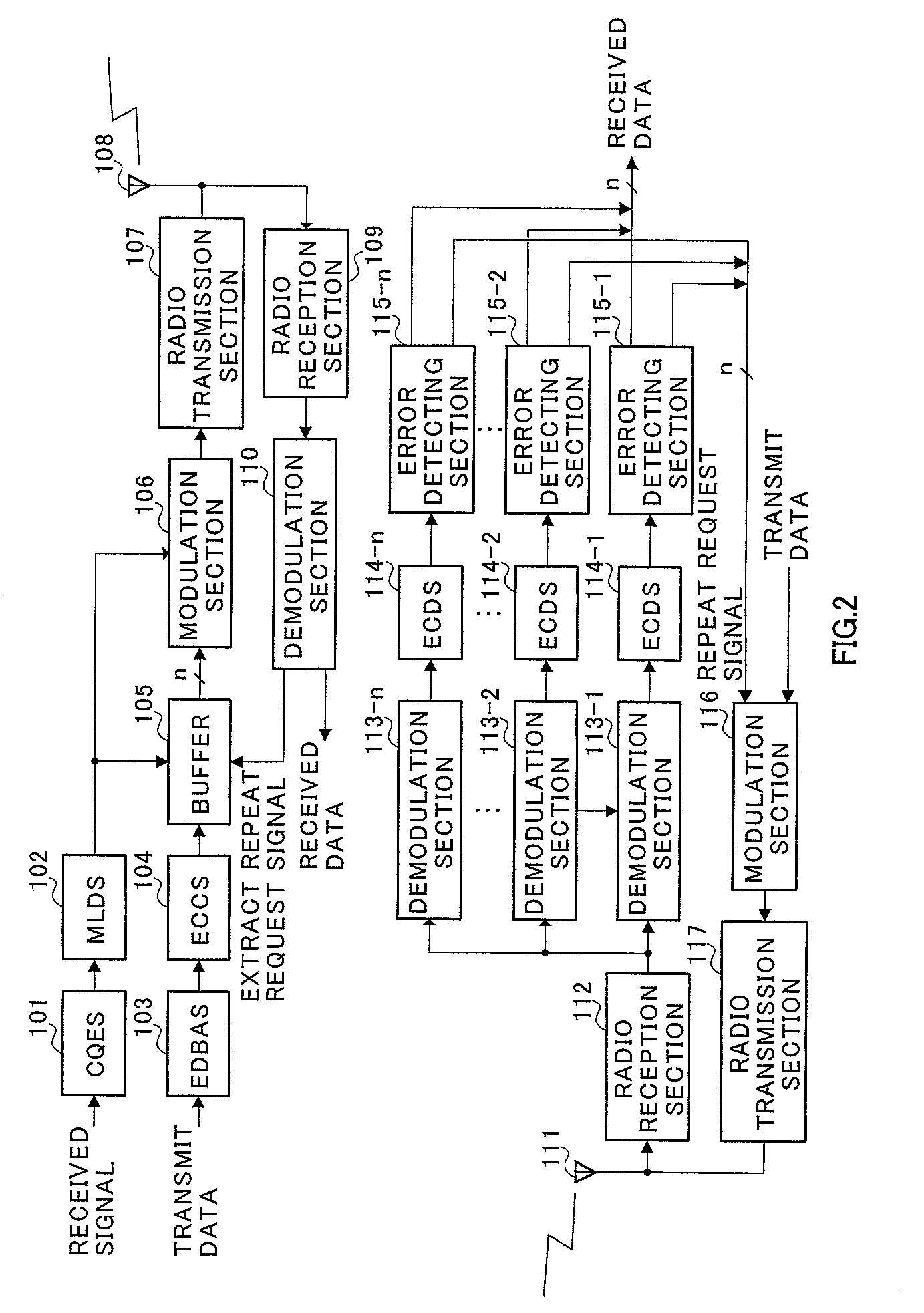Adaptive modulation communication system
- Summary
- Abstract
- Description
- Claims
- Application Information
AI Technical Summary
Benefits of technology
Problems solved by technology
Method used
Image
Examples
first embodiment
[0043] (First Embodiment)
[0044] FIG. 2 is a block diagram illustrating a configuration of an adaptive modulation communication system according to the embodiments of the present invention.
[0045] In the adaptive modulation communication system illustrated in FIG. 2, CQES(channel quality estimating section) 101 in a transmitting-side apparatus estimates a channel quality using a received signal. The estimated channel quality information is output to MLDS(modulation level determining section) 102. MLDS 102 determines a modulation level based on the channel quality information. For example, when the channel quality is good, MLDS 102 increases the modulation level, while decreasing the modulation level when the channel quality is poor. The information on the modulation level is output to buffer 105, while being output to modulation section 106.
[0046] Transmit data is output to EDBAS(error detecting bit adding section) 103, where an error detecting bit is added for each predetermined unit...
second embodiment
[0099] (Second Embodiment)
[0100] This embodiment describes a case of applying to modulation schemes where a square root of the number of total signal points is not an integer, for example, 32QAM, 8QAM, and BPSK.
[0101] Generally, in such modulation schemes, as illustrated by broken line in FIGS. 11, 13 and 15, signal points are arranged in the form of a circle. In an adaptive modulation communication system according to this embodiment, the signal point arrangement in 32QAM is set as illustrated in FIG. 11 with eight points in the I(in-phase)-axis direction and with four points in the Q(quadrature)-axis direction. The signal point arrangement in 8QAM is set as illustrated in FIG. 13 with four points in the I-axis direction and with two points in the Q-axis direction. The signal point arrangement in BPSK is set as illustrated in FIG. 15 with two points in the I-axis direction. In other words, the number of signal points in the I-axis direction is made different from the number of sign...
third embodiment
[0127] (Third Embodiment)
[0128] This embodiment describes a case of applying the adaptive modulation communication system of the present invention to star-16QAM and 16PSK modulation schemes. Herein, the case will be described of applying the adaptive modulation communication system of the present invention to star-16QAM and 16PSK modulation schemes, using 8PSK.
[0129] FIG. 17 is a diagram to explain a signal space diagram of QPSK. FIG. 18 is a diagram to explain a signal space diagram of 8PSK. In FIG. 17, with respect to a first bit (upper bit), such bits are "0" above horizontal axis 1602, while being "1" under horizontal axis 1602, with axis 1602 as a boundary. With respect to a second bit (lower bit), such bits are "0" at the left of vertical axis 1601, while being "1" at right of vertical axis 1601, as viewed in the figure, with vertical axis 1601 as a boundary. Accordingly, by determining the foregoing, it is possible to demodulate 2 bits of QPSK.
[0130] In FIG. 18, the most sign...
PUM
 Login to View More
Login to View More Abstract
Description
Claims
Application Information
 Login to View More
Login to View More - R&D
- Intellectual Property
- Life Sciences
- Materials
- Tech Scout
- Unparalleled Data Quality
- Higher Quality Content
- 60% Fewer Hallucinations
Browse by: Latest US Patents, China's latest patents, Technical Efficacy Thesaurus, Application Domain, Technology Topic, Popular Technical Reports.
© 2025 PatSnap. All rights reserved.Legal|Privacy policy|Modern Slavery Act Transparency Statement|Sitemap|About US| Contact US: help@patsnap.com



